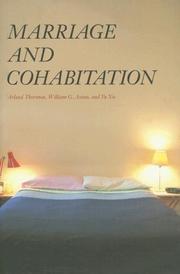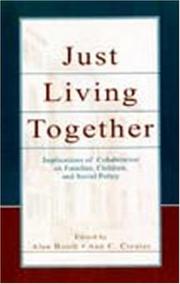| Listing 1 - 10 of 15 | << page >> |
Sort by
|

ISBN: 0700601481 0700631194 0700631690 Year: 1977 Publisher: University Press of Kansas
Abstract | Keywords | Export | Availability | Bookmark
 Loading...
Loading...Choose an application
- Reference Manager
- EndNote
- RefWorks (Direct export to RefWorks)
This volume provides the first account of the pioneering efforts at sex reform in America from the Gilded Age to the Progressive era. Despite the atmosphere of extreme prudery and the existence of the Comstock laws after the Civil War, a group of radicals emerged to attack conventional beliefs about sex, from traditional marriage to women’s chattel status in society. These men and women had in common a direct, unrespectable, iconoclastic style. They put forth outrageous journalism and had a penchant for martyrdom and for using the courts to publicize their ideologies.From rare and generally unknown sources, Hal D. Sears pieced together the story of the sex radicals and their surprising ideas. Moses Harman, a minister turned abolitionist and freethinker, is a central figure in the narrative. His Lucifer, the Light Bearer, the only journal of sexual liberty published from the early 1880s to 1907, was dedicated to free love, sex education, women’s rights, and related causes. To a great degree Harman’s publication defines the limits of social dissent in the late nineteenth century.Other members of the sex radical circle included E. B. Foote, a medical doctor who made a fortune with a home medical book crammed with sex information; Edwin Walker and Lillian Harman, who became a cause célèbre among radicals when their jailhouse honeymoon in Kansas challenged the right of the state to regulate marriage; Elmina Slenker, who promoted a theory of sexual energy sublimation and the idea that women were the superior sex; and Lois Waisbrooker, Dora Forster, Lillie White, and other feminists who, almost a century ago, taught and preached the very ideas we hear today in the women’s movement.Of course, all these people got into trouble with the law, mostly through the machinations of their archvillain, Anthony Comstock. Sears examines Comstock’s powers of postal censorship and describes Comstock’s personal vendettas against sexual dissenters, particularly the free love philosopher Ezra Heywood. He gives a legal history of obscenity and explains the sex radicals’ significance in the emergence of obscenity law.Although the sex radicals attest the important reform vitality of provincial culture in late nineteenthcentury America, until now they have been almost ignored by historians. Those who have studied sex radicalism at all, apart from its communitarian and sectarian aspects, have viewed it merely as a subsidiary of the more respectable feminist movement. In this book Sears gives careful consideration to the links between sex radicalism and spiritualism, feminism, anticlericalism, anarchism, and the freethought movement. He presents sex radicalism as a separate and unique movement which illuminates new reaches of the Victorian landscape and establishes a tradition for presentday liberation trends.
Feminism --- Free love --- Radicalism --- Sexual ethics. --- History. --- Marriage --- Sexual ethics --- Concubinage --- Unmarried couples --- Sex --- Sex ethics --- Sexual behavior, Ethics of --- Ethics --- Extremism, Political --- Ideological extremism --- Political extremism --- Political science --- Moral and ethical aspects --- History of the Americas
Book
ISBN: 0128190876 0128190868 9780128190876 9780128190869 Year: 2023 Publisher: London, England : Academic Press,
Abstract | Keywords | Export | Availability | Bookmark
 Loading...
Loading...Choose an application
- Reference Manager
- EndNote
- RefWorks (Direct export to RefWorks)
Unmarried couples. --- Sex --- History --- Gender (Sex) --- Human beings --- Human sexuality --- Sex (Gender) --- Sexual behavior --- Sexual practices --- Sexuality --- Sexology --- Cohabitation --- Domestic partners --- Living together --- Couples --- Common law marriage --- Free love --- Paleoanthropology.
Book
ISBN: 0809331020 1283970953 9780809331024 9780809331017 0809331012 Year: 2013 Publisher: Carbondale
Abstract | Keywords | Export | Availability | Bookmark
 Loading...
Loading...Choose an application
- Reference Manager
- EndNote
- RefWorks (Direct export to RefWorks)
Social problems in literature. --- Feminism --- Sex customs --- Free love --- Women and literature --- Rhetoric --- American literature --- Customs, Sex --- Human beings --- Sexual behavior --- Sexual practices --- Manners and customs --- Moral conditions --- Sex --- Marriage --- Sexual ethics --- Concubinage --- Unmarried couples --- Language and languages --- Speaking --- Authorship --- Expression --- Literary style --- English literature --- Agrarians (Group of writers) --- History --- Women authors --- History and criticism.
Book
ISBN: 1139888854 1139579525 1139572709 1139107852 1139570951 1139569147 1139573497 1283638681 1139570048 9781139569149 9781139107853 9781139570954 9781139572705 9781107020849 1107020840 9781107536302 9781283638685 1107536308 Year: 2012 Publisher: Cambridge [UK] New York Cambridge University Press
Abstract | Keywords | Export | Availability | Bookmark
 Loading...
Loading...Choose an application
- Reference Manager
- EndNote
- RefWorks (Direct export to RefWorks)
"This book has three key aims: first, to show how the legal treatment of cohabiting couples has changed over the past four centuries, from punishment as fornicators in the seventeenth century to eventual acceptance as family in the late twentieth; second, to chart how the language used to refer to cohabitation has changed over time and how different terms influenced policy debates and public perceptions; and, third, to estimate the extent of cohabitation in earlier centuries. To achieve this it draws on hundreds of reported and unreported cases as well as legislation, policy papers and debates in Parliament; thousands of newspaper reports and magazine articles; and innovative cohort studies that provide new and more reliable evidence as to the incidence (or rather the rarity) of cohabitation in eighteenth- and nineteenth-century England. It concludes with a consideration of the relationship between legal regulation and social trends"--
Unmarried couples --- Fornication --- Cohabitation --- Domestic partners --- Living together --- Couples --- Common law marriage --- Free love --- Illicit sexual intercourse --- Sex crimes --- Legal status, laws, etc. --- History. --- Social aspects --- Law --- General and Others --- Unmarried couples - Legal status, laws, etc. - England - History --- Fornication - England - History --- Unmarried couples - Social aspects - England --- Royaume-Uni
Book
ISBN: 1609383508 9781609383503 9781609383497 1609383494 9781609383497 Year: 2015 Publisher: Iowa City
Abstract | Keywords | Export | Availability | Bookmark
 Loading...
Loading...Choose an application
- Reference Manager
- EndNote
- RefWorks (Direct export to RefWorks)
Unmarried couples --- Gay couples --- Same-sex marriage --- Gay marriage --- Homosexual marriage --- Lesbian marriage --- Same-sex unions --- Marriage --- Civil unions --- Domestic partners --- Gay male couples --- Homosexual couples --- Same-sex couples --- Couples --- Cohabitation --- Living together --- Common law marriage --- Free love --- Legal status, laws, etc. --- Law and legislation --- History.
Book
ISBN: 022611841X Year: 2014 Publisher: Chicago : University of Chicago Press,
Abstract | Keywords | Export | Availability | Bookmark
 Loading...
Loading...Choose an application
- Reference Manager
- EndNote
- RefWorks (Direct export to RefWorks)
"Welcome to the European family!" When East European countries joined the European Union under this banner after 1989, they agreed to the free movement of goods, services, capital, and persons. In this book, Anca Parvulescu analyzes an important niche in this imagined European kinship: the traffic in women, or the circulation of East European women in West Europe in marriage and as domestic servants, nannies, personal attendants, and entertainers. Analyzing film, national policies, and an impressive range of work by theorists from Giorgio Agamben to Judith Butler, she develops a critical lens through which to think about the transnational continuum of "women's work." Parvulescu revisits Claude Lévi-Strauss's concept of kinship and its rearticulation by second-wave feminists, particularly Gayle Rubin, to show that kinship has traditionally been anchored in the traffic in women. Reading recent cinematic texts that help frame this, she reveals that in contemporary Europe, East European migrant women are exchanged to engage in labor customarily performed by wives within the institution of marriage. Tracing a pattern of what she calls Americanization, Parvulescu argues that these women thereby become responsible for the labor of reproduction. A fascinating cultural study as much about the consequences of the enlargement of the European Union as women's mobility, The Traffic in Women's Work questions the foundations of the notion of Europe today.
Women immigrants --- Women --- Human trafficking --- Abuse of --- Social conditions. --- europe, women, gender, labor, sex work, marriage, entertainment, personal attendants, nannies, domestic servants, european union, trade, capitalism, national policies, film, judith butler, giorgio agamben, transnational, levi-strauss, kinship, second wave feminism, gayle rubin, migrants, wives, mobility, reproduction, americanization, human trafficking, abuse, immigrants, nonfiction, history, sociology, hospitality, free love.

ISBN: 1281966665 9786611966669 0226798682 9780226798684 9781281966667 9780226798660 0226798666 Year: 2007 Publisher: Chicago University of Chicago Press
Abstract | Keywords | Export | Availability | Bookmark
 Loading...
Loading...Choose an application
- Reference Manager
- EndNote
- RefWorks (Direct export to RefWorks)
In an era when half of marriages end in divorce, cohabitation has become more commonplace and those who do get married are doing so at an older age. So why do people marry when they do? And why do some couples choose to cohabit? A team of expert family sociologists examines these timely questions in Marriage and Cohabitation, the result of their research over the last decade on the issue of union formation. Situating their argument in the context of the Western world's 500-year history of marriage, the authors reveal what factors encourage marriage and cohabitation in a contemporary society wh
Marriage --- Unmarried couples --- Young adults --- Young people --- Young persons --- Adulthood --- Youth --- Cohabitation --- Domestic partners --- Living together --- Couples --- Common law marriage --- Free love --- Attitudes. --- United States --- Social conditions --- married life, cohabitating, sociology, sociologist, academic, scholarly, research, college, university, textbook, contemporary, modern, 20th century, present day, old age, middle aged, union, western, international, global, adolescence, youth, commitment, long term, relationships, interpersonal, united states, usa, america, american, controversial, family, education, finance, wealth, income, patterns, history, historical, demographics.
Book
ISBN: 2731403942 2821853424 Year: 2004 Publisher: Presses universitaires d’Aix-Marseille
Abstract | Keywords | Export | Availability | Bookmark
 Loading...
Loading...Choose an application
- Reference Manager
- EndNote
- RefWorks (Direct export to RefWorks)
Le champ protecteur de la Convention européenne des droits de l'Homme s'étend au couple. En réalité, l'étendue de la protection accordée par la Convention varie en fonction de la nature du couple. Le couple marié bénéficie d'une protection accrue qui touche tant la formation du mariage que l'état de mariage. Le couple hétérosexuel non marié jouit quant à lui d'une protection minimale en ce sens que, si les autorités nationales n'ont pas l'obligation de le doter d'un statut analogue à celui du couple marié, elles doivent toutefois respecter la vie familiale qu'il est susceptible de faire naître. Enfin, la protection conventionnelle reconnue au couple homosexuel non marié est pour l'heure quasi inexistante : selon la Cour européenne des droits de l'Homme, la relation homosexuelle n'est pas constitutive d'une vie familiale, de sorte que ses membres ne peuvent bénéficier que du droit au respect de la vie privée. L'étendue de la protection accordée à la relation homosexuelle au nom du respect dû à la vie privée mérite toutefois d'être analysée dans la mesure où elle pourrait bien constituer un élément déterminant d'une évolution vers la reconnaissance de la vie familiale homosexuelle. En effet, les droits accordés aux homosexuels au nom du respect dû à leur vie privée prennent de plus en plus une dimension familiale et ont des incidences certaines sur leur vie de couple. En droit de la famille tout particulièrement, en raison des sensibilités et traditions nationales, la Cour met systématiquement en avant le principe d'interprétation selon lequel les normes conventionnelles doivent se lire à la lumière des conditions d'aujourd'hui. Dans ses décisions, elle prend notamment soin de s'appuyer sur l'état des législations dans les États membres. En effet, dans le domaine familial, l'existence ou non d'une tendance majoritaire au sein des droits nationaux constitue très souvent un facteur pertinent pour fixer le champ d'application de la Convention et mesurer l'étendue de…
Family law. Inheritance law
---
France
---
Law - Non-U.S.
---
Law, Politics & Government
---
Law - Europe, except U.K.
---
Marriage law
---
-Marriage law
---
-347.6 <44>
---
342.72/.73 <4>
---
Law, Marriage
---
Marriage
---
Domestic relations
---
Sex and law
---
Husband and wife
---
Familierecht. Gezinsrecht. Huwelijksgoederenrecht--Frankrijk
---
Mensenrechten. Amnesty International. Euthanasie--

ISBN: 0805839631 0585418578 9780585418575 9780805839630 1410602974 9781410602978 9781135643959 1135643954 9781135643904 1135643903 9781135643942 1135643946 9780415649476 0415649471 1138003689 1282324373 9786612324376 9781282324374 Year: 2002 Publisher: Mahwah, NJ L. Erlbaum Associates
Abstract | Keywords | Export | Availability | Bookmark
 Loading...
Loading...Choose an application
- Reference Manager
- EndNote
- RefWorks (Direct export to RefWorks)
Based on the presentations and discussions from a national symposia, Just Living Together represents one of the first systematic efforts to focus on cohabitation. The book is divided into four parts, each dealing with a different aspect of cohabitation. Part I addresses the big picture question, ""What are the historical and cross cultural foundations of cohabitation?"" Part II focuses specifically on North America and asks, ""What is the role of cohabitation in contemporary North American family structure?"" Part III turns the focus to the question, ""What is the long- and short-term i
Child development --- Families --- Family policy --- Unmarried couples --- Social policy --- Sociology of the family. Sociology of sexuality --- Age group sociology --- Family --- #SBIB:316.356.2H3360 --- Child study --- Children --- Development, Child --- Developmental biology --- Developmental psychobiology --- Child rearing --- Families and state --- State and families --- Public welfare --- Social security --- Family life --- Family relationships --- Family structure --- Relationships, Family --- Structure, Family --- Social institutions --- Birth order --- Domestic relations --- Home --- Households --- Kinship --- Marriage --- Matriarchy --- Parenthood --- Patriarchy --- Cohabitation --- Domestic partners --- Living together --- Couples --- Common law marriage --- Free love --- Gezinssociologie: alternatieve vormen van huwen en samenwonen (incl. homosexuele relaties) --- Development --- Government policy --- Social aspects --- Social conditions
Book
ISBN: 9781442255012 9781442255029 1442255013 1442255021 Year: 2016 Publisher: Lanham
Abstract | Keywords | Export | Availability | Bookmark
 Loading...
Loading...Choose an application
- Reference Manager
- EndNote
- RefWorks (Direct export to RefWorks)
"This volume completes Keith McMahon's acclaimed history of imperial wives and royal polygamy in China. Avoiding the stereotype of the emperor's plural wives as mere victims or playthings, the book considers empresses and concubines as full-fledged participants in palace life, whether as mothers, wives, or go-betweens in the emperor's relations with others in the palace. Although restrictions on women's participation in politics increased dramatically after Empress Wu in the Tang, the author follows the strong and active women, of both high and low rank, who continued to appear. They counseled emperors, ghostwrote for them, oversaw succession when they died, and dominated them when they were weak. They influenced the emperor's relationships with other women and enhanced their aura and that of the royal house with their acts of artistic and religious patronage. Dynastic history ended in China when the prohibition that women should not rule was defied for the final time by Dowager Cixi, the last great monarch before China's transformation into a republic"--Provided by publisher.
Emperors' spouses --- Mistresses --- Polygamy --- Concubinage --- Women --- Sex role --- S11/0710 --- S11/0740 --- Human females --- Wimmin --- Woman --- Womon --- Womyn --- Females --- Human beings --- Femininity --- Lovers (Mistresses) --- Paramours --- Spouses --- Common law marriage --- Free love --- Marriage --- Marriage law --- Multiple marriage --- Plural marriage --- Non-monogamous relationships --- History. --- Political aspects --- Political activity --- China: Social sciences--Women: general and before 1949 --- China: Social sciences--Sexual life: general and before 1949 --- Law and legislation --- China --- Politics and government --- Concubinage. --- Ehefrau. --- Emperors' spouses. --- Kaiser. --- Konkubine. --- Mistresses. --- Politics and government. --- Politisches Handeln. --- Sex role. --- History --- Political aspects. --- Political activity. --- 960-1912. --- China. --- Political aspects&delete& --- Political activity&delete&
| Listing 1 - 10 of 15 | << page >> |
Sort by
|

 Search
Search Feedback
Feedback About UniCat
About UniCat  Help
Help News
News